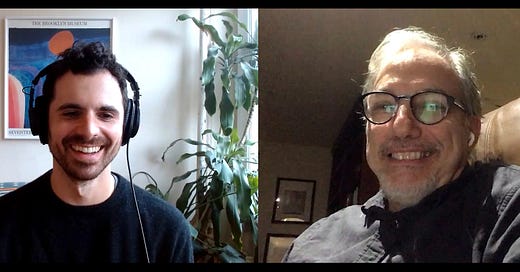As a primary source of news for countless readers, I thought it'd be helpful to understand The New York Times’ shifting vantage point on Israel and Palestine over the years. Professor Eric Alterman kindly agreed to explore the subject with me in a sequel of sorts to our earlier interview about the history of debate over Israel in the U.S.
Professor Alterman is a historian and CUNY Distinguished Professor of English and Journalism. He was the "The Liberal Media" columnist for The Nation for 25 years and is a contributing writer both to The Nation and The American Prospect. Professor Alterman is also the author of 12 books, including most recently We Are Not One: A History of America's Fight Over Israel.
A condensed transcript edited for clarity is below. Paying subscribers can also listen to the audio of our conversation:
How the NYT Has Covered Israel
Listen now (18 mins) | Audio of my conversation with Professor Alterman
Ben: Eric, welcome back to Skipped History. Today I'd like to trace the history of The New York Times’ coverage of Israel.
Let’s start with Arthur Hays Sulzberger, who became publisher of the Times in 1935. Why did he not support Israel?
EA: Consistent with the beliefs of many Reform Jews in the early 20th century, Sulzberger insisted that Judaism was a religion and that Jews were not a people. For him, what happened to other Jews was of no particular concern to American Jews.
Sulzberger took this position to its extremes. Under his watch, the Times consistently downplayed the danger Nazism posed to Europe’s Jews, and tragically, he buried stories about the Holocaust. Sulzberger resisted putting Jews in “showcase” editorial positions at the Times regardless of their qualifications.
Sulzberger was also defiantly against the creation of Israel. He supported the American Council for Judaism, an anti-Zionist Jewish group. He also supported a left-wing group of intellectuals called Ihud, which didn’t think there should be a state of Israel unless Palestinians supported one, too.
So editorially, The New York Times was really anti-Israel as long as Arthur Hays Sulzberger had control.
Ben: The elder Sulzberger was succeeded as publisher by his son, Arthur Ochs Sulzberger, in 1963. To understand how the paper’s stance on Israel evolved in the following years, can you describe the Times’ response to the controversial UN resolution in 1975?
EA: Sure. In November 1975, the General Assembly adopted Resolution 3379 declaring that “Zionism is a form of racism and racial discrimination.” The resolution demonstrated that the Left and the Third World world had increasingly turned against Israel and in support of Palestinian self-determination.
At the same time, declaring Zionism to be racism was painful to American Jews. Though for a long time, they had not cared so much about Israel, after the Six-Day War in 1967, American Jews began to identify with the defense of Israel virtually overnight.
Editor’s note: Professor Alterman and I discussed the Six-Day War at more length in our last conversation…
Likewise, there was very little criticism of Israel in the Times after the war, and once Arthur Ochs Sulzberger took over. The Times covered the UN resolution almost as if the Israeli public affairs office were writing for them.
Ben: That brings us to 1976 when the Times helped sway a related political race.
EA: That’s right: the 1976 New York Democratic senate primary, which pitted Bella Abzug, the feminist Jewish congresswoman, against Daniel Patrick Moynihan, who had been a Democratic operative and US ambassador to the United Nations when Resolution 3379 passed.
Moynihan was one of the resolution’s most vocal opponents. Riding newfound support from Jewish neoconservatives, who equated the defense of Israel with the defense of the U.S., he ran for senator the next year. The Times editorial board voted 11–2 to endorse Abzug in the primary, but Sulzberger overruled them. The paper’s endorsement likely provided Moynihan with his razor-thin ten-thousand-vote margin of victory, and he later won easily in the general election.
The election presaged a new political constellation within America’s Israel debate. From then on, neoconservatives fought to ensure the Jewish state's complete freedom of action with regard to the Palestinians and its neighbors.
Ben: Building on this freedom of action, in 1982, Israel invaded Lebanon. Can you describe how the Times covered the invasion?
EA: The invasion was kind of similar to what we’re seeing today. Israel launched a brutal strike against the Palestine Liberation Organization (PLO), then based in Lebanon. The attack included the saturation bombing of Beirut itself. Then there was this horrific episode when Israel abetted the massacre of as many as two thousand Palestinians at two refugee camps nearby (Sabra and Shatila).
On one hand, this was a real turning point in the history of media coverage of the conflict and also in the direction of the Times. The Times journalist covering the war was Thomas Friedman. He delivered some of the most intense, graphic reporting the Times had ever published on Israel’s actions.
On the other hand, the Times was then edited by a man named Abe Rosenthal, who was as partisan for Israel as a journalist could be. As executive editor, he often battled his reporters to try and get more favorable coverage for Israel and more attention to antisemitism. When Friedman filed a story describing what he’d seen — “Israeli planes, gunboats, and artillery rained indiscriminate shellfire all across West Beirut today” — the Times excised the word “indiscriminate.”
So beginning in 1982, there was a war at the Times over Israel and Palestine; between what people were reporting on the ground and what the editor felt could go in the newspaper.
Ben: You also detail close relationships between Times journalists and the Israelis they worked with. For example, when Israel’s New York Consul General, Uri Savir, was called home in 1992, you write that “he was treated to a farewell skit in his honor performed by two Times reporters, along with TV news anchors Dan Rather and Peter Jennings and the Hollywood stars Kathleen Turner and Ron Silver.”
I think the most unbelievable part of that statement is your characterization of Kathleen Turner and Ron Silver as “Hollywood Stars.” What have they ever been in?
EA: Go see the fantastic noir, Body Heat, and tell me that Kathleen Turner’s not a star.
Ben: Alright. I’ll be back in 1.5 hours.
EA: ...
Ben: ... I guess I’ll watch it another time.
How did the Times’ coverage of the Camp David Summit in 2000 reveal that an internal battle over how to cover Israel and Palestine continued?






